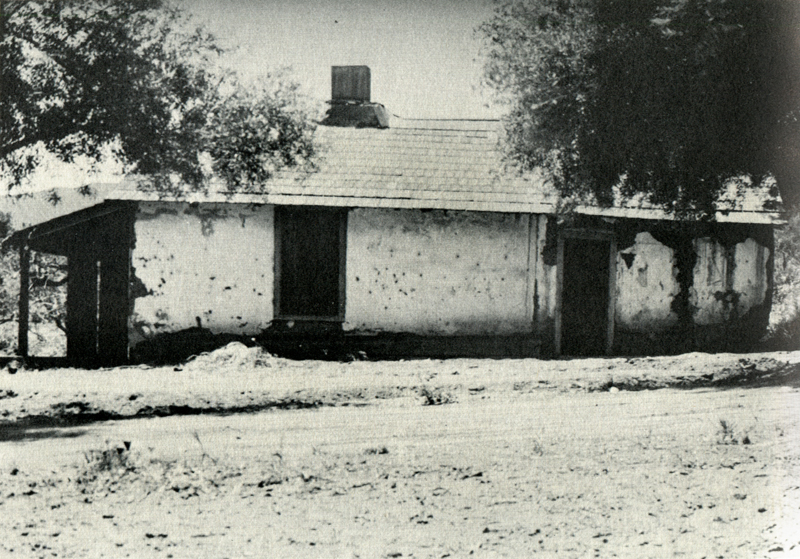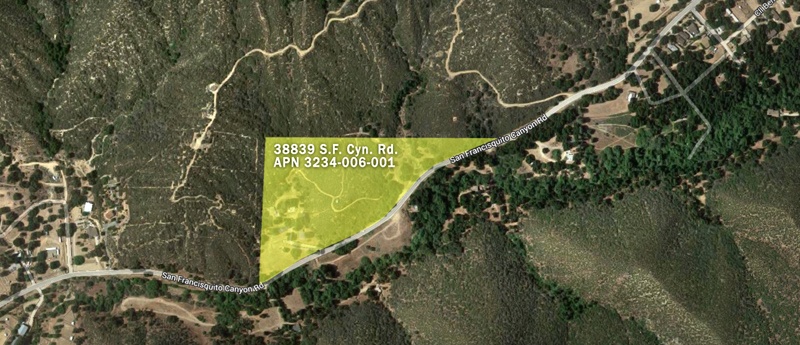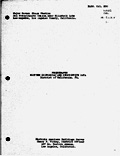|
|
Gordon's Station and Ferry.
As told by José Jesús López.
From "Saga of Rancho El Tejon" by Frank F. Latta | Santa Cruz: Bear State Books 1976 | pp. 77-79.
|
Webmaster's note. Major Gordon's Station, later called Widow Smith's, was located at what is now 38839 San Francisquito Canyon Road, just southwest of Green Valley. It was razed in the 1960s. Many sources erroneously call it Major "Gorman's."
Major Gordon was the man after whom Gordon's Station and Gordon's Ferry were named. He came to Kern County at about the time Fort Tejón was being built, and ran a ferry across Kern River just below where the present (1930) bridge is north of the foot of China Grade. He left Kern River before the time of the Overland Stages and went to Fort Tejón. There he hunted meat: deer, antelope, elk, and bear for sale to the soldiers at Fort Tejón and to the laborers who built the fort. In this he was assisted by his old associates, John Cuddy, James Gorman, Dave and Jimmie McKenzie. A short time later he built an adobe in San Francisquito Canyon on the old road, where he sold meals and stock feed to those engaged in freighting from Los Angeles to the upper country and to the San Joaquin Valley. When the Overland Stages began running, Gordon's became a regular stopping placed on that line. Gordon did not stay long after the stages began running. He sold to Luke Smith and moved to Santa Paula, where he died about 1875. I remember Mr. Gordon very well. He used to trade at my father's station near San Fernando [Lopez Station]. I have sold him many meals, lodgings, and feed for his driving team. When I knew him he was already called "Old" Major Gordon. He was a short, heavy man. He had no family that I ever knew. When I came to the Tejón in 1873 I did not know that Old Major Gordon was the man who had operated the ferry on Kern River. But I soon learned that from many people. At that time there was no ferry on Kern River. The stream was bridged. This bridge was about where the present (1930) bridge is opposite the foot of China Grade, which already had been built by the labor of Chinese miners who then were mining the sand and gravel of Kern River from the lower portion of Kern Canyon down to a point below the ridge. After I came here a second bridge was built across Kern River at the north end of Jewitt Lake. The buildings at Gordon's Ferry had been on the south bank of Kern River about two hundred yards above the ferry. They were not in existence when first I saw the place. The floods of '62 and '63 had swept the location perfectly bare of all signs of improvements. I had my information from pioneers who had seen them there. Luke Smith and his wife ran Gordon's Station for a short time and then Luke died. His widow kept the place for a number of years and gradually it became known as "Widow Smith's." Later Widow Smith died and the station passed into the hands of the Delano family, who restored the name of Gordon's Station. For a number of years Tom Delano was telegraph operator at Gordon's Station. More About Major Gordon's Station (Not from Lopez). Major Gordon's Station was erected circa 1859 by Aneas Gordon along the Butterfield Overland stagecoach route on San Francisquito Road (aka San Francisquito Canyon Road), four miles southwest of Elizabeth Lake and 20 miles north of the future town of Saugus. Update: It was located at what is now 38839 San Francisquito Canyon Road, just southwest of Green Valley. It was razed in the 1960s. See map below. According to historian Bonnie Ketterl Kane of the Ridge Route Communities Historical Society, Aneas Gordon had previously operated Gordon's Ferry on the Kern River, near present-day Bakersfield. An overhead cable was used to move a ferry, large enough to carry a coach and six or more horses, across the river.[1] The next stop along the route south out of San Francisco was Fort Tejon (est. 1854). Gordon sold the ferry in 1859 to Joseph Gale and apparently came to the Elizabeth Lake area at that time. According to Kane: "In 'Saga of El Tejon,' Lopez said that 'old' Major Gordon did not stay long at Gordon Station after the stages began running. He sold to Luke Smith and moved to Santa Paula where he died about 1875. Luke Smith then dies and the stop becomes known as 'Widow Smith's.' She sells to Tom Delano, who again calls the stop 'Gordon's Station.'"[2] It should be noted that Harris Newmark said he stopped at Gordon's Station in 1856. It's possible Newmark had the year mixed up, inasmuch as he wrote his reminiscences from memory, 60 years later. On the other hand, it's possible the names "Major Gordon's" and "Widow Smith's" were interchangeable. Historian Kirby Sanders, a career journalist and author of "Driver's Guide to the Butterfield Overland Mail Route" (2008), offers the following: While it appears that "Major Gordon's Station" and the Butterfield "Widow Smith's Station" are likely at or near the same place, there also appears to be some confusion in the naming of the place over different dates. Goddard Bailey, a United States Post Office postal inspector based in San Francisco, made the first trip of the Butterfield Overland Mail from San Francisco to Saint Louis, Mo., commencing Sept. 15, 1858. He was charged with supplying an official report to Postmaster General Aaron V. Brown with an official on the stations and the distances between them. The report was filed in October 1858. In the report, Bailey clearly identifies this station as being "Widow Smith's" and identifies its location as being 24 miles from "French John's" and a further 10 miles onward to "King's"[a][b]. Waterman Ormsby, in his 1858 description of the east-to-west journey of the first Butterfield run, does not specifically mention this station[c]. Roscoe and Margaret Conkling, in their Butterfield study published in 1947, also indicate that "the names of two others, John F. Gordon, and a Mr. Wilburn" were also associated with this station[d]. What appears to be at issue is the date and order of transfer between Anaeas Gordon and Luke Smith. The matter of reference by Harris Newmark to a stop at Gordon's Station in 1856 could also relate to a stop at Widow Smith's, using a more familiar vernacular ("Major Gordon") at the time he wrote his memoir. None of the above is intended as a criticism of others' contributions and research. Rather, it is merely to point out an historical anomaly in the record — an anomaly we would all be well served to sort out.
— Kirby Sanders REFERENCES: a. Bailey, Goddard. "California — Arrival of the Overland Mail — Itinerary of the Route," as reported in the New York Times, Oct. 14, 1858. b. Bailey, Goddard. Report to Postmaster General A.V. Brown. Full itinerary as reported by De Bow's Review and Industrial Resources, Statistics etc.; published by De Bow's Review, New Orleans and Washington City, 1858. See specifically "Internal Improvements - 1. Wagon Road to the Pacific," pp 719-721. c. Ormsby, Waterman L. "The Butterfield Overland Mail (Only Through Passenger on the First Westbound Stage)," original publications, New York Herald, Sept. 26 to Nov. 19, 1858; republished by Henry E. Huntington Library and Art Gallery, San Marino, Calif., 1942-1998. d. Conkling, Roscoe P. and Margaret B. "The Butterfield Overland Mail, 1857–1869" (3 vols), Glendale, Calif.: A.H. Clark Co., 1947. As an aside, Kirby, who lives in Houston, is pursuing a federal designation for the original Butterfield Overland route as a historic trail, in recognition of its importance as America's first real "information superhighway," running from the Mississippi River to the Pacific Coast. Further Reading: Gordon's Station and Ferry by José Jesús López, circa 1930. The remains of Major Gordon's Station were photographed and surveyed in 1936 and 1937 by Henry F. Withey, Los Angeles District Officer for the Historic American Buildings Survey (HABS). At the time, the property was owned by Herbert G. Boyd of 601 N. Jackson St. in Glendale, Calif. HABS surveys were performed at historic sites across the country under the auspices of the Works Progress Administration, one of several agencies established under FDR's New Deal to create government-sector jobs during the Depression. In his survey, Withey — an architect of some renown in Los Angeles during the 1920s — incorrectly identifies Major Gordon's as "Major Gorman's Stage Station." According to Kane[3], Major Gordon's was unrelated to Gorman Station (in Gorman) or to the man for whom the community of Gorman was named. Photographs from 1936 at the Autry National Center, sourced to the Southwest Museum (and presumably emanating from Withey), corroborate the name of the station as "Major Gordon's." According to Withey's report (HABS CAL-330), the station had a "foundation of field stone laid in adobe mud (and) walls of sun dried adobe brick plastered with adobe and whitewashed; part of front plastered with lime plaster, wood floors laid directly on the soil, ceiling and roof frame of wood, roof covered with shakes." It was re-roofed in 1933. A rendering of the floor plan accompanying Withey's report, drawn by architect Clifford T. McElroy — a designer of movie theaters in Minnesota during the 1910s — elaborates on the station's construction as follows: "Foundations are of field stone laid in adobe mortar. Walls are adobe with some field stone mixed in. Walls plastered inside and out with a plastic adobe mixed with sand. Front or south gable wall over porch, lime plastered. All other outside walls heavily whitewashed. "Walls of rooms No. 1-3-4 whitewashed, walls of Room 2 papered. Ceilings and roof projections whitewashed. Doors sash and trim painted slate gray. Floors, including porch, are 1"x6" matched pine flooring laid on 2"x4"s flat on ground. "Roof framing has not the appearance of being original material. Roofing is of redwood shakes recovered in 1933. Soil has washed down from the north, raising grade at rear of building. Rear wall leans outward, by reason of settlement, about 1'-0" at peek [sic] of gable. This occurred before the roof was reconstructed. Adobe chimney has been protected with sheet metal scraps. Adobe brick are 4"x8"x16", 1/4" joints. An occasional header course but no attention paid to vertical joints." At the time of the HABS survey, the structure was "unoccupied and neglected, being used for storage of grain and farm products," Withey writes. He notes that a photograph and reference to the station were included in an article titled "In Pursuit of Vanished Days" by Marion Parks, published in 1929 by the Historical Society of Southern California. [1] Kane, Bonnie Ketterl, "A View from the Ridge Route Vol. II: The Fort Tejon Area," Bonnie's Books, Frazier Park, Calif., 2002, Pg. 139. [2] Communication from Bonnie Ketterl Kane, Nov. 12, 2012. [3] ibid.
About José Jesús López, Majordomo of El Tejon Excerpts from "Saga of Rancho El Tejon" by Frank F. Latta (Santa Cruz: Bear State Books 1976). The book is written in the voice of José Jesús López (1853-1939), "as told to" Latta in a series of interviews conducted between 1916 and the 1930s.
Preface (by Latta), pg. xi. José Jesús López was one of the most colorful pioneers ever to operate a stock ranch in California. He came from one of the oldest and most numerous California families. It is probable that ancestors of his parents came to Alta California in 1769 with Gaspar de Portola and Father Junipero Serra. Records show that on September 8, 1771, Juan Francisco López was in the soldier escort and guard at the founding of Mission San Gabriel. In 1872, after his family had been in California more than one hundred years, Don José made a visit to the San Joaquin Valley and in 1873 he returned with a band of sheep, returned to stay. Not only did he have a good education; he was one of the most able and intelligent Californios of his time. So he was not destined to herd sheep for long. In 1874, Edward F. Beale, owner of El Tejon Ranchos, purchased part of the López sheep and employed him to handle all of the sheep on the ranchos. The sheep at one time totaled ninety-five thousand head, ranging more than 300,000 acres of land, four Mexican Land Grants, and included Ranchos El Tejon, La Liebre, Castaic [Castec] and Agua Caliente. Don José continued in charge of the sheep operation until 1885, after Beale had sold most of the sheep and stocked the ranchos with cattle. Beale then placed Don José in charge of the entire stock operation. He continued in the employ of Beale until Beale died and the ranchos were sold to a Los Angeles company by his son, Truxton Beale. He also continued with this company as active, and later as consulting cattle boss until the time of his death in 1939. It was in 1916 that I first met and interviewed Don Jose. [...] Chapter 1: From Old Spain (voice of López), pp. 1-3. My López ancestors were from Old Spain, Province of Asturias. At one time some of them, not by the name of López, lived in Seville. But the old López grandparents claimed to be Castilianos, Castillians. They had some French and Arabian blood. Ygnacio López, born in Mexico, was the founder of the López family in Alta California. Some of our family say that Ygnacio and his sons, Juan and Juan Francisco, both born in Baja California, came to Alta California in 1769 [...] Coming from Baja California, the López families went first to the state of Michoacan on the mainland and waited for an expedition to come north. They arrived in Michoacan just in time to help put down a revolution. Later, in recognition of this service, Juan and Claudio were given charge of the Indians building two of the missions, Claudio those at San Gabriel, and Juan those at San Fernando. Juan's son, Pedro, followed his father as Mayordomo over the Indians at San Fernando. This Pedro was my mother's father. Our López family came from a long line of Spanish army officers, continuing back to the time of the Conquest of Mexico, when another Juan López served as a Conquistador under Hernán Cortés. Ygnacio López' wife was María Recunda de Mora de López. There is a family tradition that this López family was connected with the Duke de Medina through these Moras. However, I have never seen any records to prove this. Claudio López was a brother of Juan and Juan Francisco. He was my great grandfather. He and his wife, María Luisa Cota de López, are buried inside the San Gabriel Mission Church. On their way to Alta California, three of the López families stayed in the state of Michoacan for a number of years, waiting for an expedition to come to Alta California. Things moved slowly in those days and the expedition was years in being organized. At last, three of the families moved up into the state of Sonora and stopped near Ures. This move was made because they thought they would be able to come sooner if they were close at hand, for the outfitting posts were on the frontier. They were in Sonora two years before they were able to come to Alta California. Both my father, Jerónimo, and my mother, Catalina, were named López. My mother was the daughter of Pedro López, and the granddaughter of Juan López and María Dolores Salgada de López. My father was the son of Esteban López and the grandson of Claudio López and María Luisa Cota de López. Claudio was Majordomo at San Gabriel Mission for more than forty years. [...] For his long service at San Gabriel, Claudio was granted the use of Rancho Anita, which later was known as Rancho Santa Anita. He did not name the rancho for the Saint. He named it for beautiful Anita Cota. He expected to marry her, but she died and he later married her cousin, María Luisa Cota. [...] In 1826 he became Alcalde of Pueblo de Los Angeles. From my parents and from the generation of my grandparents, I learned that in Spain our López family was very wealthy and belonged to the aristocracy of Castile. Of course I did not know the original Claudio or any of his brothers or sisters, but my grandfather, Pedro López, did. Both Chico and Pedro López told many stories about all of these original colonists. The original brothers, Claudio, Juan and Juan Francisco, had two sisters who came to California. One, María Francisca, married an Ortega and the other, María de la Encarnación, married a Verdugo. You see, through these early marriages, I am related to almost every person in Southern California who is descended from the early Spanish colonists. [...]
|
The site owner makes no assertions as to ownership of any original copyrights to digitized images. However, these images are intended for Personal or Research use only. Any other kind of use, including but not limited to commercial or scholarly publication in any medium or format, public exhibition, or use online or in a web site, may be subject to additional restrictions including but not limited to the copyrights held by parties other than the site owner. USERS ARE SOLELY RESPONSIBLE for determining the existence of such rights and for obtaining any permissions and/or paying associated fees necessary for the proposed use.












